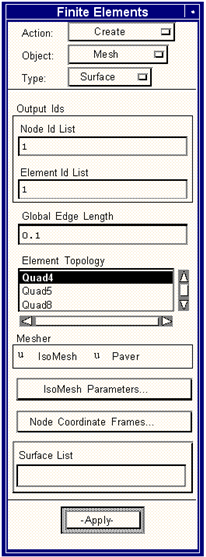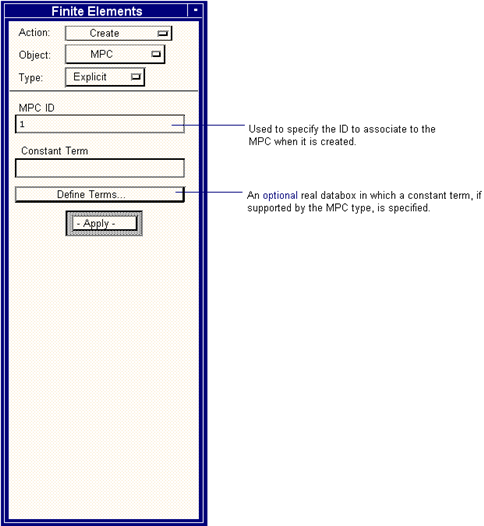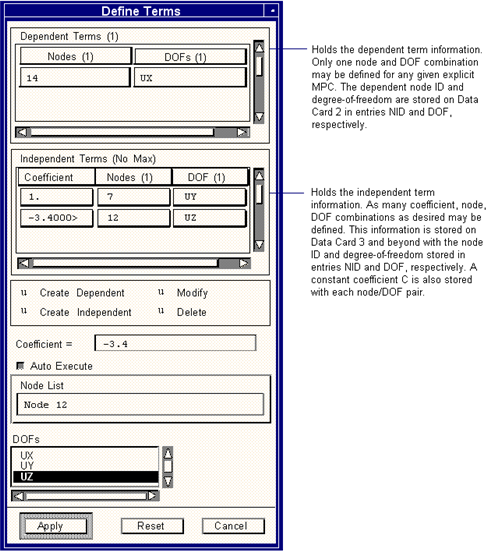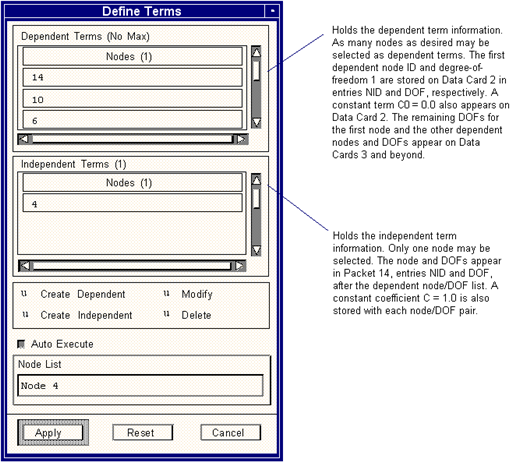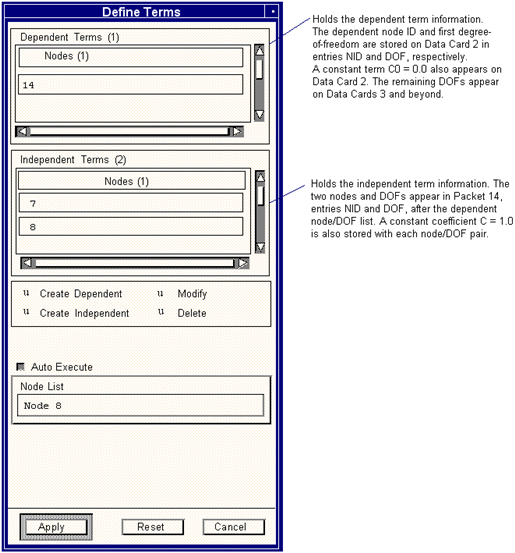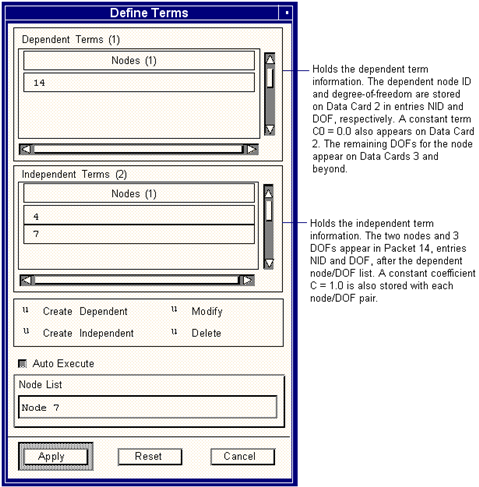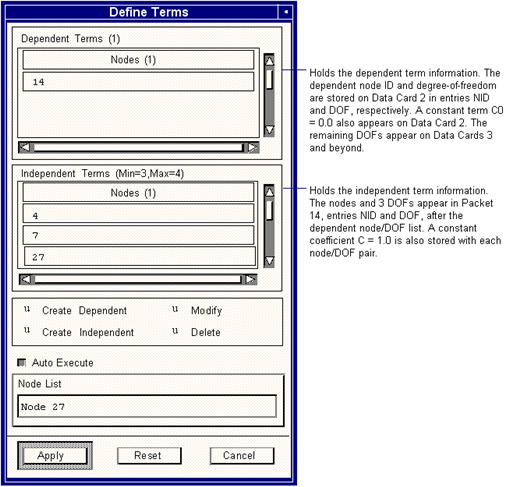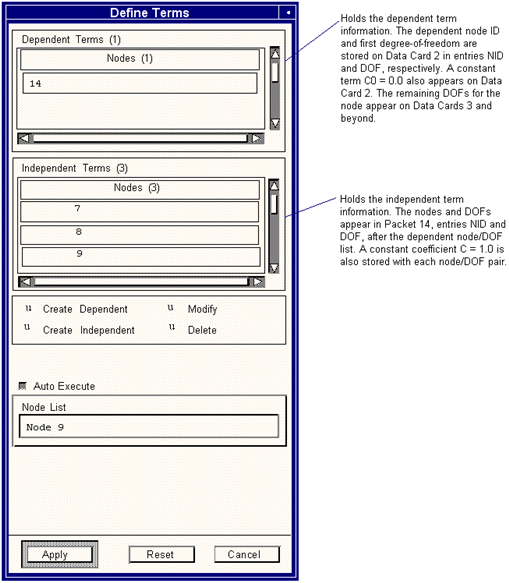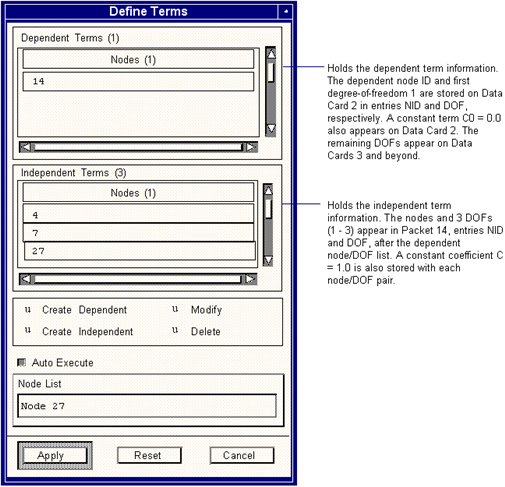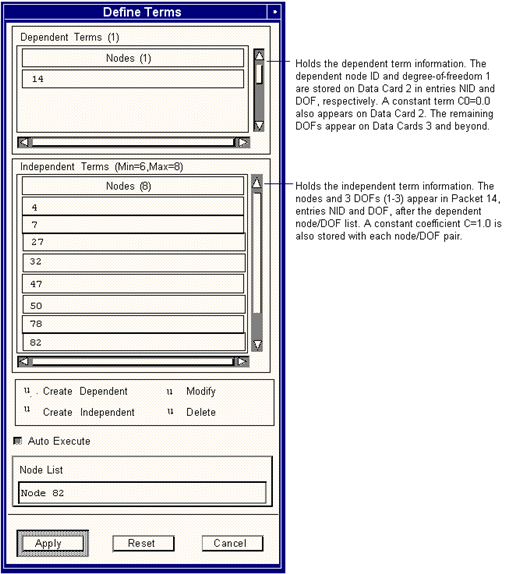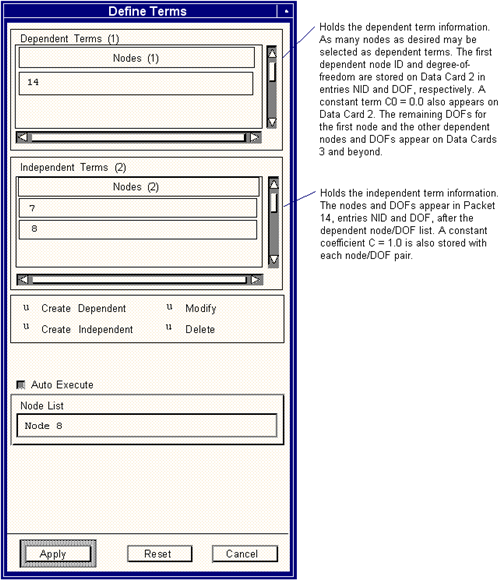XXXXXXXXXXXXXXXXXXXXXXXXXXXXXXXXXXXXXXXXXXXXXXXXXXXXXXXXXXXXXXXXXXXXXXXXXXXXXXXXXXXXXXXXXXXXXXXXXXXXXXXXXXXXXXXXXXXXXXXXXXXXXXXXXXXXXXXXXXXXXXXXXXXXXXXX''"> Finite Elements
Finite elements in Patran allows the definition of basic finite element construction. Created under Finite Elements are the nodes, element topology and multi-point constraints.
For more information on how to create finite element meshes, see
Mesh Seed and Mesh Forms (p. 25) in the Reference Manual - Part III.
Nodes
Nodes in Patran will generate Packet 01 entries in the neutral file (see
Packet Type 01: Node Data (p. 728) in the Patran Reference Manual). Nodes can be created either directly using the
Node object, or indirectly using the
Mesh object. The Node ID is stored on the Header Card, entry ID. Each node location, defined relative to a coordinate frame, is defined by 3 values. These values are stored on Data Card 1, entries X, Y and Z. The coordinate frame is stored on Data Card 2, entry CID. If no reference frame is assigned, the global system (CID = 0) is used. Nodes that are exported to the neutral file are always resolved relative to the global system (CID = 0). The condensation flag, entry ICF on Data Card 2, indicates whether nodes are referenced by one or more elements (ICF = 1) or are unreferenced (ICF = 0). Data Card 2 contains entries which currently cannot be referenced within Patran and are set to default values. These include the Node Type (GTYPE = G), Number of Degrees of Freedom (NDF = 6), Node Configuration (CONFIG = 0) and the 6 permanent single point constraint flags (PSPC = 000000).

Elements
Finite Elements in Patran assigns element connectivity, such as Quad/4, for standard finite elements. The type of element to be created is not determined until the element properties are assigned. Elements can be created either discretely using the
Element object, or indirectly using the
Mesh object. Each element results in the creation of a Neutral File Packet 02 (see
Packet Type 02: Element Data (p. 729) in the Patran Reference Manual). The Element ID is stored on the Header Card, entry ID. The shape (bar=2, tri = 3, quad = 4, tet = 5, wedge = 7, hex = 8) is stored on the Header Card, entry IV. The element’s nodes are listed on Data Card 2, entry LNODES.
Multi-Point Constraints
Multi-point constraints (MPCs) can be created from the Finite Elements menu. These are special element types which define a rigorous behavior between several specified nodes. The forms for creating MPCs are found by selecting MPC as the Object on the Finite Elements form. Each defined MPC results in the creation of a Neutral File Packet 14 (see
Packet Type 14: MPC Data (p. 735) in the Patran Reference Manual). The MPC ID is stored on the Header Card, entry MPC ID. The MPC Set ID--Header Card, entry MPC SID--always equals 1.
MPC Types
To create an MPC, first select the type of MPC to be created from the option menu. The explicit and implicit MPC types defined for PATRAN 2.5 are available and described in the following table.
MPC Type | Analysis Type | Description |
| Structural | Creates an explicit MPC between a dependent degree-of-freedom and one or more independent degrees-of-freedom. The dependent term consists of a node ID and a degree-of-freedom, while an independent term consists of a coefficient, a node ID, and a degree-of-freedom. An unlimited number of independent terms can be specified, while only one dependent term can be specified. An optional constant term can be specified. |
| Structural | Creates a rigid MPC between one independent node and one or more dependent nodes in which all six structural degrees-of-freedom are rigidly attached to each other. An unlimited number of dependent terms can be specified, while only one independent term can be specified. Each term consists of a single node. There is no constant term for this MPC type. |
| Structural | Creates a rigid MPC between one independent node and one or more dependent nodes in which all three translational degrees-of-freedom are rigidly attached to each other. An unlimited number of dependent terms can be specified, while only one independent term can be specified. Each term consists of a single node. There is no constant term for this MPC type. |
Linear Surface to Surface (LSS) | Structural | Creates an implicit MPC intended to connect topologically incompatible elements to model a continuum. Each dependent term consists of a node while two nodes describe the independent term. There is no constant term for this MPC type. |
Linear Surface to Volume (LSV) | Structural | Creates an implicit MPC intended to connect a plate model to a solid model. The plate node displacements and rotations are defined in terms of the displacements of the solid element nodes. Each dependent terms contains one node while each independent terms consists of two nodes. There is no constant term for this MPC type. |
Linear Volume to Volume (LVV) | Structural | Creates an implicit MPC intended to connect topologically incompatible solid elements to model a continuum. Each dependent term contains one node while each independent term consists of a minimum of three nodes and a maximum of four nodes. All three translational structural degrees-of-freedom are automatically specified. There is no constant term for this MPC type. |
Quadratic Surface to Surface (QSS) | Structural | Creates an implicit MPC intended to connect topologically incompatible elements to model a continuum. Each dependent terms consists of a node and each independent term consists of three nodes. There is no constant term for this MPC type. |
Quadratic Surface to Volume (QSV) | Structural | Creates an implicit MPC intended to connect a shell model to a solid model. The plate node displacements and rotations are defined in terms of the displacements of the solid element nodes. Each dependent term contains one node and each independent term consists of three nodes. There is no constant term for this MPC type. |
Quadratic Volume to Volume (QVV) | Structural | Creates an implicit MPC intended to connect topologically incompatible solid elements to model a continuum. Each dependent term containing one node while each independent term consisting of eight nodes. All three translational structural degrees-of-freedom are automatically specified. There is no constant term for this MPC type. |
| Structural | Creates an implicit MPC intended to define a vector between two nodes along which a dependent node must move. Each dependent term consists of a node while each independent term consisting of two nodes. There is no constant term for this MPC type. |
Degrees-of-Freedom
Whenever a list of degrees-of-freedom are expected for an MPC term, a listbox containing the valid degrees-of-freedom is displayed on the form. The following degrees-of-freedom are supported by the PATRAN 2 Neutral File Preference for MPCs:
Degree-of-freedom | Analysis Type |
UX | Structural |
UY | Structural |
UZ | Structural |
RX | Structural |
RY | Structural |
RZ | Structural |
Important: | Care must be taken to make sure that a degree-of-freedom that is selected for an MPC actually exists at the nodes. For example, a node that is attached only to solid structural elements will not have any rotational degrees-of-freedom. However, Patran will allow you to select rotational degrees-of-freedom at this node when defining an MPC. |
Explicit MPCs
This subordinate MPC form appears when the Define Terms button is selected on the Finite Elements form, and Explicit is the selected type. The name EXPLICIT will appear in Packet 14, Data Card 1, entry TYPE.
Rigid (Fixed, Pinned)
This subordinate MPC form appears when the Define Terms button is selected on the Finite Elements form, and Rigid (Fixed or Pinned) is the selected type. The name RIGID will appear in Packet 14, Data Card 1, entry TYPE.
Linear Surface to Surface (LSS) MPCs
This subordinate MPC form appears when the Define Terms button is selected on the Finite Elements form, and Linear Surf-Surf is the selected type. The name LSS will appear in Packet 14, Data Card 1, entry TYPE.
Linear Surface to Volume (LSV) MPCs
This subordinate MPC form appears when the Define Terms button is selected on the Finite Elements form, and Linear Surf-Vol is the selected type. The name LSV will appear in Packet 14, Data Card 1, entry TYPE.
Linear Volume to Volume (LVV) MPCs
This subordinate MPC form appears when the Define Terms button is selected on the Finite Elements form, and Linear Vol-Vol is the selected type. The name LVV will appear in Packet 14, Data Card 1, entry TYPE.
Quadratic Surface to Surface (QSS) MPCs
This subordinate MPC form appears when the Define Terms button is selected on the Finite Elements form, and Quadratic Surf-Surf is the selected type. The name QSS will appear in Packet 14, Data Card 1, entry TYPE.
Quadratic Surface to Volume (QSV) MPCs
This subordinate MPC form appears when the Define Terms button is selected on the Finite Elements form, and Quadratic Surf-Vol is the selected type. The name QSV will appear in Packet 14, Data Card 1, entry TYPE.
Quadratic Volume to Volume (QVV) MPCs
This subordinate MPC form appears when the Define Terms button is selected on the Finite Elements form, and Quadratic Vol-Vol is the selected type. The name QVV will appear in Packet 14, Data Card 1, entry TYPE.
Slide MPCs
This subordinate MPC form appears when the Define Terms button is selected on the Finite Elements form, and Slider(12) is the selected type. The name SLIDE will appear in Packet 14, Data Card 1, entry TYPE.



